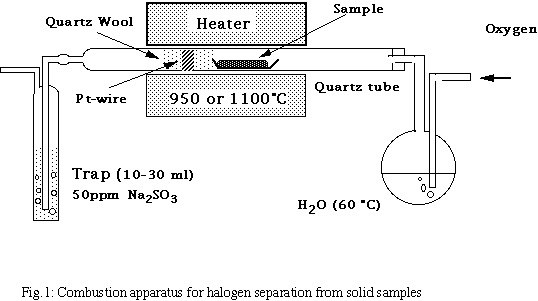The analysis of halogens, with a special reference to I, in geological and biological samples using pyrohydrolysis for preparation and ICP-MS and IC for measurement.
Bernhard Schnetger (1), Yasuyuki Muramatsu (2)
(1) Institute for Biology and Chemisty of the Marine Environment
(ICBM), University of Oldenburg, P.O. 2503, 26111 Oldenburg, Germany
(2) Divison of Radioecology, National Institute of Radiological
Sciene, Isozaki 3609, Hitachinaka-shi, Ibaraki, 311-12 (Japan)
Summary
A method for determining iodine, bromine, chlorine and fluorine
in geological and biological materials is described. In a quartz
tube, solid material was heating up to 1100 °C under a wet
oxygen flow (pyrohydrolysis). By this process the halogens (I,
Br, Cl, F) were separated from the matrix and then collected in
a receiver solution. Chemical yield of iodine was determined by
a radioactive tracer. Inductively coupled plasma mass spectrometry
(ICP-MS) and ion chromato-graphy (IC) measurement was used for
the determination of the halogens. The method was optimized by
investigating different experimental conditions. All four halogens
can be trapped in the receiver solution from one combustion procedure.
Precision and accuracy were evaluated by the analysis of environmental
standard reference materials (rock, soil, milk, leaves, marine
tissue). The concentrations in the materials analyzed ranged from
0.006 - 50 mg/kg for I, 0.06 - 1300 mg/kg for Br, 50 - 1100 mg/kg
for F and 400 - 11000 mg/kg for Cl. The lower values represent
the practical detection limit of this method. The analytical results
between this method and certified values are in good agreement.

This paper has been published in: Analyst, 121, 1627-1631 (1996)
Values for geostandards are published in:
Schnetger B., Muramatsu Y and Yoshida S. (1998): Iodine (and
other Halogens) in twenty six geological reference materials by
ICP-MS and ion chromatography. Geostandards Newsletter 22, No.
2, 181-186.
Back to the MBG Homepage
Back to Barnis Homepage
